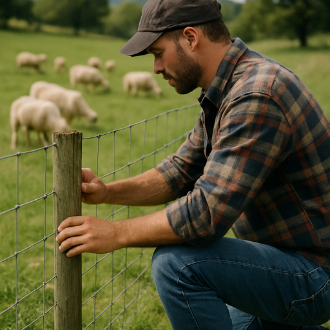How to Prevent Losing Your Farm Animal: Tips and Best Practices to Ensure Their Safety
By Lost'Him Team • February 22, 2025

Farm animals—cows, sheep, goats, pigs, poultry, and others—are generally attached to their environment, but escapes and losses can happen more easily than expected. A damaged fence, sudden fright, lack of space, change in routine, or absence of familiar landmarks can lead an animal to wander off.
Fortunately, effective precautions exist to prevent such incidents and ensure the safety and well-being of your farm animals.
1. Secure Fences and Enclosures
👉 Best practices for reliable fencing:
- Regular inspection: Check barbed wire, mesh, and posts at least once a month.
- Use sturdy and appropriate materials: Prefer electric fences or tightly woven wire mesh.
- Ensure the proper height for each species.
- Monitor access points: Make sure gates and doors have secure locks and remain closed.
💡 Frequent visual inspections prevent 80% of escapes caused by fencing failures.
2. Provide a Secure and Stimulating Environment
👉 Creating a comfortable living space:
- A sufficiently large area to meet the specific needs of each species.
- Set up varied spaces: Grazing areas, resting zones, and play sections.
- Provide shelters and trees: Animals need shaded spots and natural refuges.
- Offer natural enrichment: Branches, rocks, climbing structures for goats, mud baths for pigs, and perches for poultry.
💡 A well-stimulated animal is less likely to explore beyond its enclosure.
3. Be a Stable and Reassuring Guide
👉 Adopt good interaction practices:
- Maintain a consistent routine: Fixed times for feeding, movement, and care.
- Use a calm voice and gentle gestures to create a trustful environment.
- Spend time with them: Animals accustomed to human presence are less stressed and less likely to flee.
- Avoid abrupt handling: A negative experience can trigger escape behavior.
💡 An animal that feels secure with its handler is less likely to seek escape.
4. Identify Animals and Use Tracking Devices
👉 Identification and tracking solutions:
- Ear tags and tattoos: Mandatory for cattle, sheep, and goats.
- Microchipping: Recommended for recreational animals.
- GPS collars: To monitor the movements of goats, horses, and sheep.
💡 An identified and tracked animal is much easier to recover quickly.
5. Respond Effectively to Stressful Situations
👉 Anticipate and manage stressful events:
- Secure high-risk areas: Add extra fencing near roads or forests.
- Provide retreat spaces: Quiet, secure shelters where animals can instinctively take refuge.
- Monitor animals during changes: New pastures, new arrivals, or farm work can cause instability.
💡 Animals should always have a known, secure retreat to prevent panic-driven escapes.
6. Improve the Relationship Between Animals and Their Environment
👉 Optimizing their living conditions:
- Gradually introduce them to new pastures: Allow them to explore under supervision.
- Install visual markers: Trees, shelters, and fixed structures serve as reference points.
- Avoid overly exposed areas: Animals prefer spaces where they feel protected.
💡 An animal that feels at home has no desire to wander away.
7. Common Mistakes to Avoid
- ❌ Neglecting fence maintenance.
- ❌ Leaving animals alone in a new environment.
- ❌ Failing to anticipate stress periods (shearing, habitat change, transport).
- ❌ Underestimating the need for stimulation and positive interactions.
💡 Prevention is always more effective than intervention after the fact.
Conclusion: Constant Vigilance and a Strong Bond to Prevent Losses
- ✅ Secure fences and check their condition regularly.
- ✅ Provide a stimulating environment to prevent boredom.
- ✅ Be a stable and reassuring guide.
- ✅ Anticipate stressful periods and provide appropriate shelters.
💡 An animal that feels safe in a well-adapted environment and trusts its caretaker is much less likely to flee. 🌻🐑🐖🐓💚
 EN
EN  FR
FR